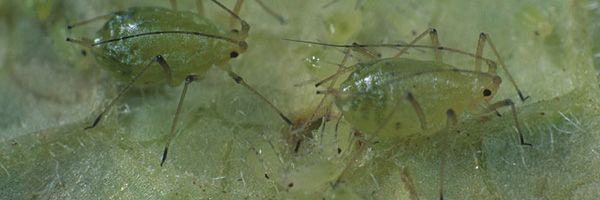
Aphids
Aphids comprise a large number of species. Some of them multiply on the potato and can form colonies, whilst itinerant aphids only visit the crop occasionally during flights.
- Aphids colonising the potato crops
Six aphid species are frequent on potato leaves and may be found worldwide.
If conditions are favourable, they can form large colonies on potato plants:
- Myzus persicae (the green peach and potato aphid - photos 1 and 2) favours the lower leaves. It is one of the most dangerous species for the transmission of potato viruses. Some populations of this species are insecticide-resistant.
- Macrosiphum euphorbiae (the green and pink potato aphid - photos 3 and 4) is a large aphid with both green and pink forms. The colonies are often very prevalent on the flower stalks.
- Aulacorthum solani (the digitalis and greenhouse potato aphid - photo 5) is a medium-sized yellow to green aphid with darker streaks on the winged form. It favours the lower and intermediate leaves of the plants.
- Aphis frangulae (the alder buckthorn-potato aphid - photo 6) is a medium-sized aphid of a greenish colour. It is mainly abundant in Eastern Europe. Another, very similar, species can also be observed on potatoes in hot climates. This is Aphis gossypii (the melon and cotton aphid).
- Aphis nasturtii (the buckthorn aphid - photos 7 and 8) is a temperate climate species, found mainly in Eastern Europe but has also become more common in France over the last ten years. This is a small yellow aphid, also found on the lower leaves.
- Aphis fabae (the black bean aphid - photos 9 and 10), is a polyphagous species; it is very harmful to many vegetable crops. The subspecies A. fabae solanella may be found on potatoes, mainly in hot climates (Mediterranean and tropical).
To this list of species present on potato leaves, should be added Rhopalosiphoninus latysiphon (the bulb and potato aphid), which multiplies on potato sprouts in storage facilities and may cause losses of germinative vigour.
- Itinerant aphids
The winged forms of other itinerant aphid species, which do not form colonies on potato plants, may also briefly visit potato fields.
These include the cereal aphids, Rhopalosiphum padi (the cherry-oat aphid - Photo 11), Rhopalosiphum maidis (the green corn aphid), Schizaphis graminum (the small grain aphid), Sitobion avenæ (the grain or brown wheat ear aphid) and aphids colonising other crops, e.g. Brachycaudus helichrysi (the leaf-curling plum aphid - Photo 12), Phorodon humuli (the hops aphid - Photo 13), Cavariella aegopodii (the carrot aphid - Photo 14), Lipaphis erysimi (the turnip aphid) and Myzus certus which are among the most common species in Western Europe.
In the USA, new species have similarly been identified over the last ten years: Acyrthosiphon pisum (the green pea aphid - Photo 15), Aphis helianthi (the sunflower aphid) and Capitophorus eleagni.
The itinerant aphid species, which can visit potato fields with high alate populations, can have a significant effect in the dissemination of non-persistent viruses such as PVY or PVA. However they are not involved in the transmission (persistent mode) of PLRV, because aphids need to remain for quite a long time in the crop before they become viruliferous.





